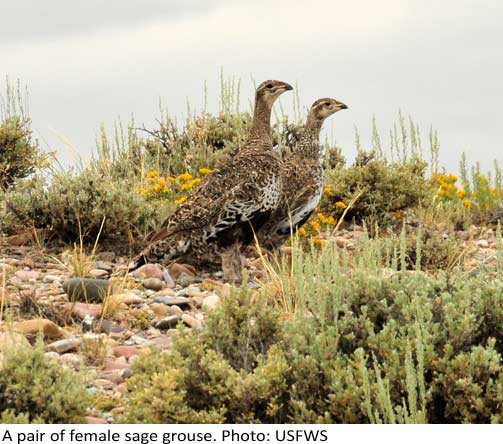A Rancher's Perspective on Sage Grouse Conservation
By: Amos P. Eno
Posted on:08/11/2014 Updated:02/25/2016Two weeks ago, I wrote about my discussion with Terry Messmer on the work he is is doing to conserve sage grouse and sagebrush-steppe habitat with private landowners in Utah. This week, I had the opportunity to speak with one of those ranchers, Jay Tanner of Grouse Creek.
A decade ago, Terry Messmer, PhD and his graduate students from Utah State University Extension's Community-Based Conservation Program started working with Jay Tanner on his ranch. Messmer and his colleagues have moved on to work with other ranchers, but with their help and the subsequent technical and financial support from the NRCS through the Sage Grouse Initiative and Utah's Grazing Improvement Program and Watershed Restoration Initiative, Tanner has accomplished 12,000 acres of rangeland restoration, native plant seeding, and juniper removal on his land.
Juniper is a conifer native to the American West, but a combination of fire suppression, historic overgrazing by livestock and favorable climate conditions have led to an invasion of juniper into the sagebrush-steppe where it was formerly scarce. This trespasser is a water thief in a desert habitat where water is scarce. It also shades out and competes with understory grasses and herbs for water and nutrients – the very same plants sage grouse use for cover and forage. Taller junipers also serve as perches for birds of prey.
It has been five years since juniper was removed from the ranch, and sage grouse populations have increased in the areas without trees. But it was not a quick recovery. Tanner emphasized that, especially in the desert habitat, everything takes time; “It’s unrealistic to remove juniper one year and have sage grouse come back the next.”
 Patience and a willingness to be flexible were major themes of our discussion. While numerous studies and management plans have been written about sage grouse and sagebrush steppe-habitat restoration (many of which can be found on our Conservation Habitat Management Portal), local conditions vary, and what works in southern Wyoming may not work to the same degree in northwestern Utah.
Patience and a willingness to be flexible were major themes of our discussion. While numerous studies and management plans have been written about sage grouse and sagebrush steppe-habitat restoration (many of which can be found on our Conservation Habitat Management Portal), local conditions vary, and what works in southern Wyoming may not work to the same degree in northwestern Utah.
“Sometimes I think [we] go in with preconceived notions, and are sometimes fighting prejudices of what will work and what won’t,” said Tanner, “but I think we still have plenty to learn.”
As part of the habitat restoration effort, Tanner applied the herbicide 2, 4-D to control unwanted brush prior to seeding. At the time, some of the wildlife biologists didn’t like the technique because they thought it might be too broad spectrum and kill everything.
But the application of 2, 4-D worked, and all involved later agreed that it was an effective technique for controlling weed competition.
On the BLM lands Tanner leases, they created a green strip of forage kochia. The purpose of the green strip was twofold: to reduce wildfire occurrence and size, and to provide food for sage grouse. Forage kochia, a hardy semi-evergreen perennial shrub, was chosen because it has: a tolerance for the rugged climate of northwestern Utah; good fire tolerance; competitiveness with the infamous invasive cheatgrass; and provides food and cover for upland game birds like sage grouse.1
To date, research done on the green strip has shown the forage kochia not to be a large portion of the sage grouse’s diet. But Tanner thinks that conclusion might have been premature – that the plants weren’t fully established at the time.
Encouragingly, Tanner is but one of a many in the northwestern Utah working to restore sage grouse habitat. “I think private landowners here have made significant strides for sage grouse conservation,” he says. Tanner adds that, while landowners like him, with help from government programs like those mentioned above, have been working to conserve sage grouse for almost a decade, similar efforts on public lands are just getting started.
This is not an indictment; Tanner genuinely expresses “hope that the public lands can catch up,” which is a sentiment I think we all can share.
 Sign In
Sign In
 Sign In
Sign In
